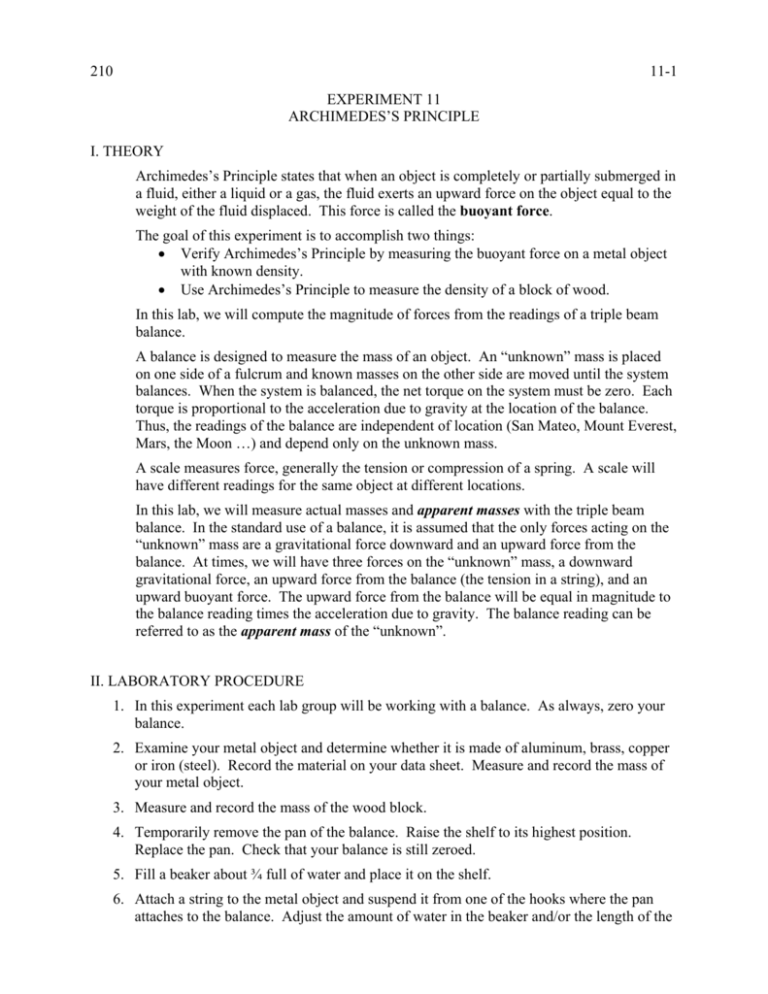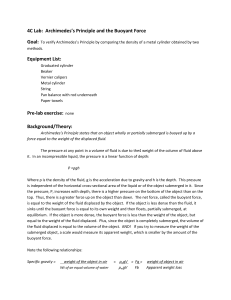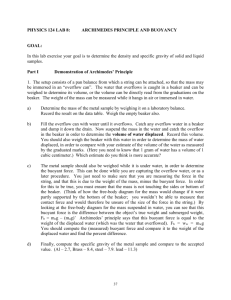Archimedes' Principle Lab: Buoyancy & Density Experiment
advertisement

210 11-1 EXPERIMENT 11 ARCHIMEDES’S PRINCIPLE I. THEORY Archimedes’s Principle states that when an object is completely or partially submerged in a fluid, either a liquid or a gas, the fluid exerts an upward force on the object equal to the weight of the fluid displaced. This force is called the buoyant force. The goal of this experiment is to accomplish two things: • Verify Archimedes’s Principle by measuring the buoyant force on a metal object with known density. • Use Archimedes’s Principle to measure the density of a block of wood. In this lab, we will compute the magnitude of forces from the readings of a triple beam balance. A balance is designed to measure the mass of an object. An “unknown” mass is placed on one side of a fulcrum and known masses on the other side are moved until the system balances. When the system is balanced, the net torque on the system must be zero. Each torque is proportional to the acceleration due to gravity at the location of the balance. Thus, the readings of the balance are independent of location (San Mateo, Mount Everest, Mars, the Moon …) and depend only on the unknown mass. A scale measures force, generally the tension or compression of a spring. A scale will have different readings for the same object at different locations. In this lab, we will measure actual masses and apparent masses with the triple beam balance. In the standard use of a balance, it is assumed that the only forces acting on the “unknown” mass are a gravitational force downward and an upward force from the balance. At times, we will have three forces on the “unknown” mass, a downward gravitational force, an upward force from the balance (the tension in a string), and an upward buoyant force. The upward force from the balance will be equal in magnitude to the balance reading times the acceleration due to gravity. The balance reading can be referred to as the apparent mass of the “unknown”. II. LABORATORY PROCEDURE 1. In this experiment each lab group will be working with a balance. As always, zero your balance. 2. Examine your metal object and determine whether it is made of aluminum, brass, copper or iron (steel). Record the material on your data sheet. Measure and record the mass of your metal object. 3. Measure and record the mass of the wood block. 4. Temporarily remove the pan of the balance. Raise the shelf to its highest position. Replace the pan. Check that your balance is still zeroed. 5. Fill a beaker about ¾ full of water and place it on the shelf. 6. Attach a string to the metal object and suspend it from one of the hooks where the pan attaches to the balance. Adjust the amount of water in the beaker and/or the length of the 210 11-2 string so that the metal object is completely submerged in the water, but not touching the sides or bottom of the beaker. 7. Measure and record the balance reading. 8. Remove the metal object and replace it with the wooden block and the metal sinker, with only the metal sinker submerged, completely. Measure and record the balance reading. Make sure neither object is touching the beaker. 9. Repeat the previous step with both the sinker and the wooden block completely submerged. 10. Empty the beaker and put the lab equipment away. Wipe up any water on the balance or lab table. III. CALCULATIONS and analysis NOTE: Calculate all forces in newtons. Make a table with all of your measurements in both grams and kilograms in separate columns. FOR THE METAL OBJECT: Determine the experimental buoyant force as follows. • Draw a free-body diagram for the metal object when it was submerged in water. • Determine the weight of the metal object. • Determine the tension in the string when the metal object was submerged. • Using Newton’s First Law, determine the experimental buoyant force on the object. Determine the theoretical buoyant force as follows. • Use the measured mass of the object and its density from the table to find the volume of the metal object. Material Water Aluminum Brass Copper Iron or Steel • Density (103 kg/m³) 1.00 2.70 8.56 8.89 7.85 Using the volume of the metal object and the given density of water, calculate the theoretical buoyant force on the object. Calculate the percent difference between the experimental and the theoretical buoyant force. FOR THE WOOD BLOCK: Determine the density of the wood block. Use only the balance readings indicated in the procedure and the given density of water. Show your work clearly.









